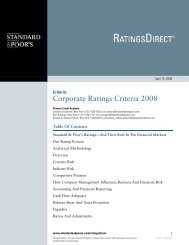European Infrastructure Finance Yearbook - Investing In Bonds ...
European Infrastructure Finance Yearbook - Investing In Bonds ...
European Infrastructure Finance Yearbook - Investing In Bonds ...
You also want an ePaper? Increase the reach of your titles
YUMPU automatically turns print PDFs into web optimized ePapers that Google loves.
PROJECT FINANCE/PUBLIC-PRIVATE PARTNERSHIPS<br />
102 ■ NOVEMBER 2007<br />
will look to the ability of the project to undertake<br />
the activities on a stand-alone basis, and any links<br />
to external parties.<br />
Cash management<br />
Nearly all project structures employ an<br />
independent trustee to control all cash flow the<br />
project generates, based on detailed project<br />
documents that define precisely how cash is to be<br />
managed. This arrangement helps prevent cash<br />
from leaking out of the project prior to the<br />
payment of operating expenses, major<br />
maintenance, taxes, and debt obligations. <strong>In</strong> those<br />
cases where there is no trustee, the<br />
creditworthiness of the project will be linked<br />
directly to the cash manager, which is usually the<br />
sponsor. Projects seeking investment-grade ratings<br />
will have cash-management structures that<br />
prevent any distributions to sponsors--including<br />
tax payments--unless all expenses are fully paid,<br />
reserves are full, and debt-service coverage rations<br />
looking back and forward for a sufficient period<br />
are adequate.<br />
Sovereign Risk<br />
A sovereign government can pose a number of<br />
risks to a project. For example, it could restrict<br />
the project’s ability to meet its debt obligations by<br />
way of currency restrictions; it could interfere<br />
with project operations; and, in extreme cases,<br />
even nationalize the project. As a general rule, the<br />
rating on a project issue will be no higher than<br />
the local-currency rating of the project in its host<br />
country. For cross-border or foreign currencydenominated<br />
debt, the foreign currency rating of<br />
the country in which the project is located is the<br />
key determinant, although in some instances debt<br />
may be rated up to transfer and convertibility<br />
(T&C) assessments of the country Standard &<br />
Poor’s has established. A T&C assessment is the<br />
rating associated with the probability of the<br />
sovereign restricting access to foreign exchange<br />
needed for servicing debt obligations. For most<br />
countries, Standard & Poor’s analysis concludes<br />
that this risk is less than the risk of sovereign<br />
default on foreign currency obligations; thus,<br />
most T&C assessments exceed the sovereign<br />
foreign currency rating. A non-sovereign project<br />
can be rated as high as the T&C assessment if its<br />
stress-tested operating and financial<br />
characteristics support the higher rating.<br />
A sovereign rating indicates a sovereign<br />
STANDARD & POOR’S EUROPEAN INFRASTRUCTURE FINANCE YEARBOOK<br />
government’s willingness and ability to service its<br />
own obligations on time and in full. The<br />
sovereign foreign currency rating acts as a<br />
constraint because the project’s ability to acquire<br />
the hard currency needed to service its foreign<br />
currency debt may be affected by acts or policies<br />
of the government. For example, in times of<br />
economic or political stress, or both, the<br />
government may intervene in the settlement<br />
process by impeding commercial conversion or<br />
transfer mechanisms, or by implementing<br />
exchange controls. <strong>In</strong> some rare instances, a<br />
project rating may exceed the sovereign foreign<br />
currency rating if: the project has foreign<br />
ownership that is key to its operations; the project<br />
can earn hard currency by exporting a commodity<br />
with minimal domestic demand, or other riskmitigating<br />
structures exist.<br />
For cross-border deals, however, other forms of<br />
government risk could result in project ratings<br />
below the T&C rating. A government could<br />
interfere with a project by restricting access to<br />
production inputs, revising royalty and tax<br />
regimes, limiting access to export facilities, and<br />
other means (see “Ratings Above The Sovereign:<br />
Foreign Currency Rating Criteria Update,”<br />
published on RatingsDirect on Nov. 3, 2005).<br />
Business and Legal <strong>In</strong>stitutional<br />
Development Risk<br />
Even though a project’s sponsors and its legal and<br />
financial advisors may have structured a project<br />
to protect against readily-foreseeable<br />
contingencies, risks from certain country-specific<br />
factors may unavoidably place lenders at<br />
concomitant risk. Specifically, risk related to the<br />
business and legal institutions needed to enable<br />
the project to operate as intended is an important<br />
factor. Experience suggests that in some emerging<br />
markets, vital business and legal institutions may<br />
not exist or may exist only in nascent form.<br />
Standard & Poor’s sovereign foreign currency<br />
ratings do not necessarily measure this<br />
institutional risk or country risk, and so equating<br />
country risk with a sovereign’s credit rating may<br />
understate the actual risk the project may face<br />
(see “<strong>In</strong>vestigating Country Risk And Its<br />
Relationship To Sovereign Ratings <strong>In</strong> Latin<br />
America,” published on April 4, 2007).<br />
<strong>In</strong> some cases, institutional risk may prevent a<br />
project’s rating from reaching the host country’s<br />
foreign currency rating, despite the project’s other



